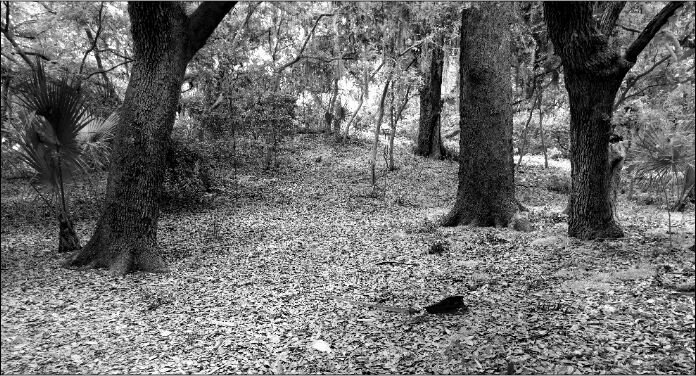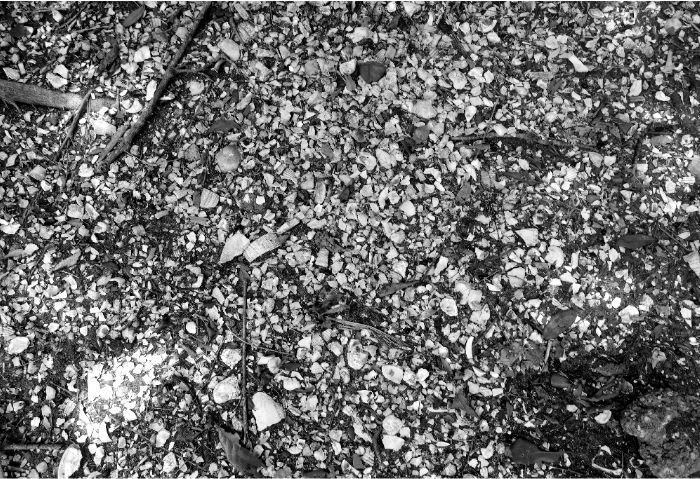Mound at "Jungle Prada-St Petersburg, Florida"
American Mound visible through the hardwood treeline is covered by fallen leaves.
While visiting other North American Mound locations, we decided to remain at “St Petersburg” a little longer in order to continue honoring legacy of Aboriginal People who inhabited the area. There is an important archaeological treasure located near the eastern shore of “Boca Ciega Bay” that encompasses almost 1000 acres (10 hectares). This impressive site at “Park Street North and Elbow Lane” is within an “urban neighborhood”, adjoins a community “‘park, and was added to the “National Register of Historic Places” in 2003.
“Jungle Prada” is a large mound complex or village once inhabited by Indigenous People, referred to as Tocobaga, that are said to be direct descendants of people of the “Safety Harbor” cultural period. The site includes a 13-foot flat-topped mound, a plaza, middens, and burial mounds, which agrees with early survey records showing existence of a large mound that may have a ramp descending westward with other smaller mounds and a plaza located nearby toward the west. We’re looking forward to traversing the location and learning more about our Ancestors.
For instance, archaeological tests done on the large mound (aka “Anderson” or “Narvaez” Site) and associated “midden” resulted in “recovery of a large well-dated assemblage of “lithic artifacts” which were “dominated by microlithic drills and the debris resulting from their production and repair.” One definition of ‘microlith’ reads: a small stone tool usually made of flint or chert and typically a centimeter in length and half a centimeter wide. It is said they were made by humans from around 35,000 to 3,000 years ago. Reportedly, Microliths were used in spear points and arrowheads. Some archaeologists suggest that these specialized tools were used mainly to drill shell, bone and shark teeth, and to make beads, indicating that large-scale craft production may have taken place at the “Jungle Prada” complex. These details are significant.
We arrived at the site on a sunny afternoon, noticing the wooded area consisting of cabbage palms, thatch palms, live oaks, and various other trees, shrubs and plants. We sensed the reason for using “jungle” in the site’s name—it befits this visual experience—highlighted by many shades of green visible in the natural vegetation. And although the meandering pathways and open ground spaces were blanketed with mixtures of dried leaves, palm fronds and tree limbs, most of the terrain was inundated with mollusk shells, shell fragments, and possibly parts of tools and craft items as mentioned in the above paragraph. Interesting.
A myriad of shells and fragments embedded in sandy soil near “Boca Ciega” coastline.
It seems like everywhere we walked, especially around the sloped elevations, there were so many shell fragments in different sizes and shapes. Naturally, when visiting ancient Indigenous sites, we leave things where they are observed because we recognize the importance of the phrase…”take only photographs, leave only footprints.” Truth is—these sacred mounds and villages are noble footprints of early inhabitants on the land and we are honored by their presence.
Continuing to enjoy the stroll, we were surprised to see beautiful peacocks roosting on the branch of an old oak tree sitting on top of a small mound in the distance. Incidentally, the correct name for these large pheasants is “peafowl.” Only males are called peacocks and they drag colorful 4-5-foot iridescent blue and green tail feathers behind them, like a train on a wedding gown. Peacocks proudly strut their stuff, fanning their “train” to display bright blue, green, red and gold eyespots, when trying to court or mate with females or “peahens.” Generally, peahens are soft brown and green in color and usually mate with the peacock who shakes the biggest tail feathers and makes the loudest noises. Ahhh…bliss for them is often too noisy for some folks. At any rate, these peacocks seem to enjoy the natural abundance available here.
Also, we spotted lovely butterflies (black with bright yellow stripes) gracefully fluttering around the dense greenery along the pathway. Later these beauties were identified as Zebra Longwing, the “state” butterfly of “Florida”. Females deposit eggs on the leaves and tendrils of purple passion flowers, which are larval host plants for numerous butterflies. We noticed the distinctive leaves (three lobes) of passionflower vines intermingled with other foliage, so butterflies would find this area enticing. Although the beautiful lavender passion flowers were absent, we enjoyed watching the butterflies. Plus, Indigenous people used both fruit (maypop) and roots of this plant for food and medicinal purposes.
Image of zebra wing butterfly flying over foliage under hammock.
We walked along the perimeter, towards the water, where the dense forest of trees and shrubs continued on both sides of the sandy pathway. The wooden boardwalk we encountered led to a serene spot over a narrow waterway that was full of mangrove trees and shoreline vegetation. Based on an area map, this might be “Long Bayou” which is located north of the mound “park” and flows into “Boca Ciega” Bay to the Gulf of Mexico. Well…wherever we were…this secluded natural setting was a pleasurable reward.
Dense mangrove trees and plants, just west of the “Boca Ciega Bay, Florida” coastline.
Finally, we arrived at the picturesque “Boca Ciega” Bay. There were lots of interesting rocks and stones of varying colors and sizes scattered along the shore, as well as many mangroves, palms, and other coastal plants. While turning to scan the terrain behind us, we observed light and dark sandy soil, embedded with shell fragments, and an interesting downward slope beneath thick vegetation bordering the edge of the site. Apparently, we have been standing on a portion of the mound that overlooks the bay—a place chosen by the Ancestors to connect with the vast natural resources of land and sea.
What a thrilling realization and culmination to an incredible journey to honor the legacy of First Nation people.
“Boca Ciega” Bay coastline, within close walking distance from Indigenous Mound
Following is a video of the mound site at "Jungle Prada, St Petersburg".




